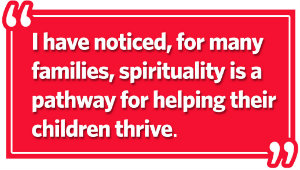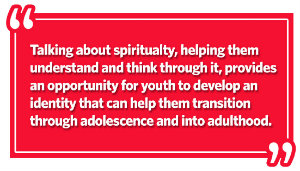Thriving, Not Just Surviving: The Spiritual Side of Positive Youth Development


James M. Loy, Miami University's College of Education, Health, and Society
Listen to the audio podcast
Read the story
Growing up can be tough for anyone. But for some youths, especially those struggling to thrive in environments fraught with adversity, inequality and poverty, the path to adulthood can be exceptionally difficult.
For these adolescences, life’s challenges can be nearly insurmountable. And without proper support or guidance, many will find hopeful futures as contributing members of society increasingly out of reach.
“There is a huge imbalance,” says Dr. Anthony James. “If we look at the youth that aren’t developing on the trajectory that we like, it is usually youth in poverty. It is usually the youth who come from communities that lack. They have a harder time focusing on long-term goals like education because their stomachs are grumbling. Because there is more violence in their community. Because people have lost hope. Or there are more immediate options for survival.”
An assistant professor of family science in Miami University’s College of Education, Health and Society (EHS), James is deeply concerned with these issues. His mission is to help families and their children overcome the barriers to prosperity that are so often caused by economic disparity, racial oppression, and discrimination.
He wants to help these families gain the skills and resources needed to become successful within the environments they must endure, which first means better understanding the contexts that these families are embedded in across our broader social systems.
For James, context matters greatly, and it is part of an ongoing thread of inquiry that runs through his research on positive youth development (PYD). Here, his focus is largely on spirituality, and the role it plays in the lives of youth, how it helps build productive identities, and its potential to encourage positive connections to their social worlds.
A Pathway to Spiritualty
As the name suggests, PYD focuses on the positive, not the negative. That is, it’s not about “fixing” youths. PYD, rather, is more about helping adolescences move toward a more promising future. It’s about nurturing meaningful relationships with the caring adults and social institutions in their lives. It’s about imbuing youth with the tools to optimize development through mutually beneficial interactions between those youth and institutions in their social worlds.
A leading framework of modern PYD research is known as the Five Cs, which includes competence, confidence, connection, character, and caring. Originally advanced, largely, by developmental scientist Richard Lerner, this model posits that as youths build and acquire these characteristics, they move along a trajectory that ultimately leads to the sixth C, which is contribution.
 Once this sixth C is reached, youths are considered to be thriving. And James is interested in how spiritualty might be connected to this process.
Once this sixth C is reached, youths are considered to be thriving. And James is interested in how spiritualty might be connected to this process.
“I have noticed, for many families, spirituality is a pathway for helping their children thrive,” says James. “And the language of thriving is key to literature on PYD. That is the outcome that families desire. That is what we hope. That they develop certain qualities that allow them to successfully navigate adolescence and transition to become contributing adults in society.”
The praises of spiritually are often sung. Among those who consider themselves to be spiritual typically claim it offers a sense of purpose and meaning. For others, it also informs morals and values, and can even provide a framework for navigating the complexity of an otherwise very confusing world.
And while spirituality can mean very different things to many different people, it is most commonly described as transcendence, which means having a sense of connectedness to some larger purpose, or having a concern with a greater good beyond selfish desires.
The intrinsic value that spirituality purports to carry has made it of interest for many PYD scholars and practitioners. However, until recently, the direct connections were not clear.
“For years, people just relied on anecdotal information regarding whether or not it is a good thing for youth to be spiritual,” says James. “It is a term that we hear quite a bit about in society, but very little empirical evidence shows that it is true, that when youth are spiritual they tend to also have these other qualities that lead to thriving.”
So with access to eight years of data, collected during a comprehensive national PYD 4-H study that included multiple assessment waves of over 1800 youths, James began to look into this potential link more closely.
And some strong connections emerged.
Spiritualty’s Empirical Support
In his first study, published in the Journal of Applied Developmental Science with coauthors Mark Fine and Linda Jo Turner, James found that spirituality was, in fact, positively correlated with increases in all six Cs.
As youths’ self-perceived notions of spirituality rose, so too did their levels of competence, confidence, connection, character, and caring, as well as their overall contributions to external social environments. Additionally, the research also established a long-term link between spirituality and the character “C” in particular, which strengthened the idea that spiritually can be an internal asset that stays with youth as they mature.
“Then we said, well, if this is that important, then we should know what are the contextual factors that help produce or help grow spirituality in young people,” James says. “One of the consistent findings of PYD is that youth really need a champion. They need a positive and caring adult in their lives. So we found that when families produce an environment that is conducive to communication about spirituality, then that tends to correlated to spirituality scores positively.”
This, then, provided the basis for the second study published in the Family Relations Journal. Beyond just anecdotal speculation, it provided specific empirical evidence that the presence of positive caring adults within a supportive community setting was an important part of fostering youth spirituality.
More recently, James and Fine also published a third study in the Journal of Adolescence, which further explored how the youths themselves conceptualized their spirituality.
The researchers first developed three broad categories of spiritualty. These included establishing meaning in life (youth who found spiritually to be a way to transcend the self), being a good person, (youth who used spirituality for moral guidance and pathway to positive social connections), and ambiguous spirituality (youth who reported being spiritual but couldn’t articulate what that meant).
Then each category was tested against the Five Cs model. And, again, a distinct pattern emerged.
Youths from the first two categories where far more competent, confident, caring, connected to others, and more motivated by positive character traits. The third “ambiguous” category, while still positively correlated to each “C,” was less substantial.
“There was a consistent pattern that the more articulate youth, who could better articulate their sense of spiritualty, scored higher on these Cs of PYD,” James explains. “And it tells us that the better youth are able to not only internalize a sense of spiritualty, but be able to articulate it, the higher they tend to score on these measures or indicators of PYD.”
Going forward, this research will have implications for parents, teachers, and community leaders who hope to nurture the positive growth of youths either at home, in school, or through any number of development programs.
Talking about spiritualty, helping them understand and think through it, provides an opportunity for youth to develop an identity that can help them transition through adolescence and into adulthood.
For anyone concerned with helping adolescences not just survive, but to actually thrive, there are a few key ways to think about positive youth development. And it is becoming clear that spirituality is an additional pathway.
“Youths’ spiritual identity should not necessarily take a back seat to any other thoughts on positive youth development that we usually think about like character or confidence,” says James. “Youth spirituality is important as well. And so for parents and practitioners who make that their focus, they have empirical support to move forward with that type of work.”

